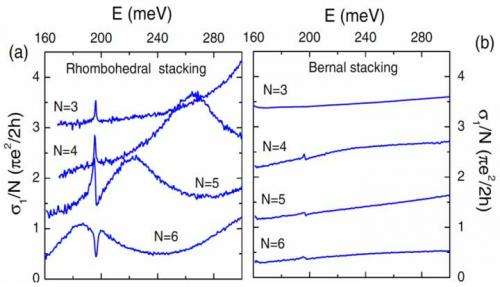Infrared absorption boosted by layering sheets of graphene

(Phys.org)—Since its discovery in 2004, graphene has been hailed as a "wonder material" due to its almost unbelievable properties. At just one atom thick, a single two-dimensional layer is stronger than diamond, conducts electricity better than copper, and conducts heat better than any known material. The hexagonal honeycomb lattice that makes up the material allows for extreme flexibility, but also makes for the most impermeable material ever found, shutting out even the tiniest helium atoms.
And when sheets of graphene are stacked, the resulting "few-layer graphene" can either function as a semi-metal or a semi-conductor, depending on the order and thickness of the layers.
Studies of the effects of stacking order on graphene are in relative infancy, but recent experiments from scientists working at the National Synchrotron Light Source at Brookhaven National Laboratory have shed light on the chameleonic nature of this material.
A team of scientists, led by Tony Heinz of Columbia University, compared infrared absorption of few-layer graphene samples stacked in two ways: a zigzag ABA pattern called Bernal stacking, in which matched top and bottom layers sandwich a third layer that is offset by an atom's length; and a rhombohedral ABC pattern where the top layer is shifted yet another atom's length away from the center sheet of graphene.
This slight shift in the top layer of graphene is all it takes to make the material's basic properties change. The team found that rearranging the layers into an ABC stacking order drastically increases the amount of infrared light the few-layer graphene will absorb in selective wavelength ranges. It's a bit like if you arranged Lego blocks in different patterns and found that they changed colors as a result.
This is because changes in stacking order alter the amount of available states for electrons to inhabit both at rest and when they're excited after absorbing infrared light. The team also found that phonons – the mechanical vibrations of the carbon atoms forming each graphene sheet – are also affected by the stacking arrangement due to their strong connection with the electronic excitations. When the electronic absorption grows, the phonon absorption grows too.
Using NSLS, they were able to accurately measure the amount of infrared light these differently stacked samples were absorbing. "The few-layer graphene samples we studied are all very small, as small as ten micrometers in size," said Columbia University physicist Zhiqiang Li. "The synchrotron radiation is critical to our measurements because it has very high intensity and can be focused to a small spot on our samples, which enables infrared measurements with good signal-to-noise ratio."
Li said further explorations into the flexible and controllable properties of graphene could lead to a wide range of applications in electronics and photonics, such as solar panels or photo-detectors.
The research was performed by scientists from Columbia University, the Spanish National Research Council, the National Research Council of Italy, Sapienza University, Case Western Reserve University, and Brookhaven National Laboratory.
Provided by Brookhaven National Laboratory














.jpg)





